Alleviation: An International Journal of Nutrition, Gender & Social Development, ISSN 2348-9340
Volume 2, Number 2 (2015) : 1-7
©Arya PG College, Panipat & Business Press India Publication, Delhi
www.aryapgcollege.com, www.apcjournals.com
Water, Sanitation and Hygiene (WASH) Practices amongst Slum Girls of Chandigarh
1 Dr. Ritu Pradhan & 2 Monika
1Assistant Professor,2 Post Graduate Student
Department of Foods and Nutrition, Government Home Science College, Chandigarh (India)
E-mail: sharmapritu@yahoo.com
Introduction
Good nutrition is the fundamental basic requirement for positive health, functional efficiency and productivity. Nutrition and health are two entities which are closely related to each other and any ill effect on one of them acts on the other. It is rather a stupendous task to maintain or achieve a good level of health and nutrition in a country like India, where poverty, illiteracy, unemployment etc. are so prevalent. It is the children, especially of poor segment, who form the vulnerable group (Buri and Sai 1996).
The school age is one of the crucial periods of life as about 40 per cent of physical growth and 80 per cent of mental growth take place during this age (Chanden and Sehgal 1994). Deaths due to malnutrition among children have been reduced but these continue to exist among children from poor section (Census 2011). Still after over 50 years of independence, there are cases of malnutrition among peri-urban children (5 to 15years). Thus both nutritional and health status are most essential for comprehensive care of children in recent period (Jaishree 2001).
Rapid industrialization has resulted into phenomenal growth of urban slum settlements in many big cities of India in recent past. Slum population living in adverse conditions represents nutritionally vulnerable groups that need immediate attention. Information regarding socio- economic factors, dietary intake and morbidity in relation to nutritional status of children living in slums is scarce (Rao et al 2000). In large cities, one -third to one -half of the population lives in peri-urban slums and about 15 per cent of the male work force and 25 per cent of female work force have no regular employment. Economic constraints force both the husband and wife to work. Even children do work to give hand to the income of the family. This compulsion creates its own problems on the dietary and child rearing practices of migrant families. It also places greater responsibilities at home on female children for care of siblings and cooking etc (Mathur 1993).
Gopalan (1989) in fact, pointed out that the problems of urban slums in India would be of greater dimension and that they would need far more attention than in the past. Nutritional status of slum children is even poorer than rural children causing low health status and malnourishment. Malnourishment is even higher among slum girls due to menstrual cycles and poorer attention given to girls as compared to boys (Kaul 1998). However unlike rural areas, urban slums are characterized by adverse living conditions and therefore need special attention (Basta 1997).
The term slum and its definition vary from country to country depending upon the socio-economic conditions of each society. They are known by different terms in different towns of India. The term slum is called kartas, gallies, juggi- jhompri in Delhi. Under Section-3 of the Slum Area Improvement and Clearance Act, 1956, slums have been defined as mainly those residential areas where dwellings are in any respect unfit for human habitation by reasons of dilapidation, overcrowding, faulty arrangements and designs of such buildings, narrowness or faulty arrangement of streets, lack of ventilation, light, sanitation facilities or any combination of these factors which are detrimental to safety, health and morals (Mohanty 2005). The United Nation Agency UN- Habitat defines slum as a run-down area of a city characterized by substandard housing and squalor and lacking in tenure security (Prakash 2011). In recent years, slum area population has been growing at a very high rate because majority of population belongs to socio economically backward classes and mostly migrated from rural areas to more developed areas to earn more through higher-paying manual labor compared to the low-returns of agriculture and with the hope of better means of livelihood.
This peri-urban population lives at a level of extreme poverty with the result that they are more prone to infections (Mohanty 2005). People living in slums face problems of housing, access to drinking water and sewage facilities. Residents live in overcrowded situation, a majority of them with dirty floors and poor ventilation which can lead to rapid spread of respiratory and skin diseases. Also, the lack of safe drinking water facilities creates the risk of water borne diseases.
The presence of stored water further promotes the breeding of mosquitoes and diseases such as malaria and dengue. It was estimated that over one third of slum households have no access to bathroom and toilet facilities, promoting open defecation which in turn leads to spread of fecal-oral disease and parasitic infestation (Census 2011).
Keeping in view the limited availability of scientific research data, it was of interest to study the Water, Sanitation and Hygiene (WASH) Practices amongst slum girls (6 to 12 years) of Chandigarh.
Methodology
The present Cross-sectional study was undertaken to study water, sanitation and hygiene (WASH) practices amongst slum girls (6 to 12 years) of Chandigarh. The study respondents comprised of 500 girls residing in four slum areas namely Indira colony, Sector 25 – D colony, Baapu Dham Colony (BDC) and Maulijaagra.
Data were collected from Indira colony dispensary, home visits and in collaboration of YTTS (NGO).
The proposed sample was studied with the help of self designed questionnaire that included demographic profile and questions related to type and size of family; housing characteristics, parent occupation and states they belong to ascertain the floating population. BMI was calculated to assess nutritional status of the sampled respondents. The following classification was used to classify the respondents (Table 1):
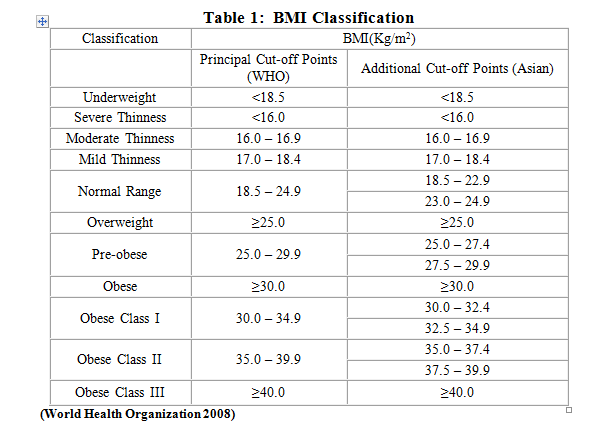
The questionnaire was pretested on a pilot sample of 30 adolescent girls. Parents and study participants were well informed about the objectives of the current research work and their consent for participation in the study was also taken.
Results and Discussion
Age Group of Respondents
The study respondents when classified according to age revealed that out of the study
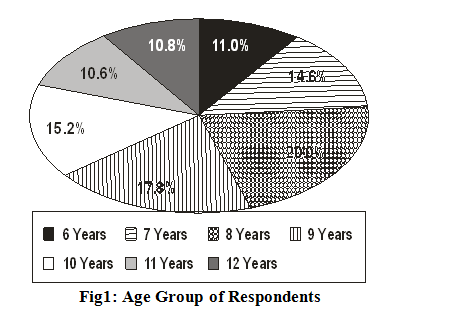
sample of 500, 20 per cent of the respondents were of 8 years, 17.8 per cent were of 9 years, 15.2 per cent of 10 years, 14.6 per cent of 7 years while remaining 11 per cent, 10.6 per cent and 10.8 per cent were of 6 years, 11 years and 12 years respectively (Fig 1).
Native State of Respondents
It can be seen from the Fig 2 that 37.2 per cent of the respondents belonged to Uttar Pradesh, followed by Bihar (20.6%), Punjab (15.2%), Haryana (13.8%), and Chandigarh
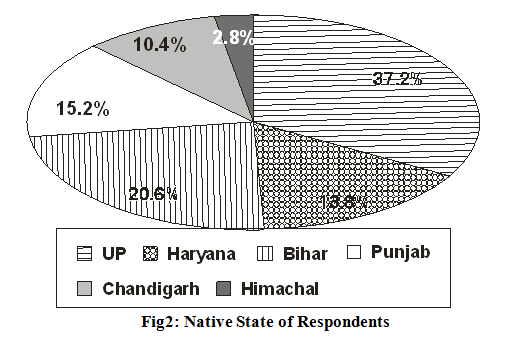
(10.4%) and Himachal Pradesh (2.8%). Center for research and rural development found Uttar Pradesh, Bihar, Jharkhand and also neighboring state of Haryana, Himachal Pradesh and Rajasthan as the primary places from where people migrate to Chandigarh (Census 2011).
Type of House of Respondents
It is highlighted in the Fig 3 that majority of the respondents (52.4%) used to live in Pucca houses, followed by Kaccha houses (47.6%).
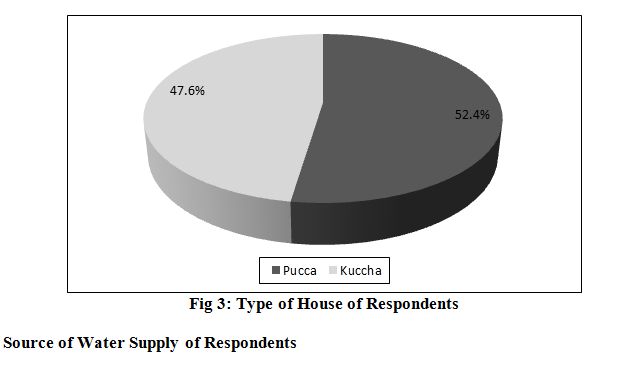
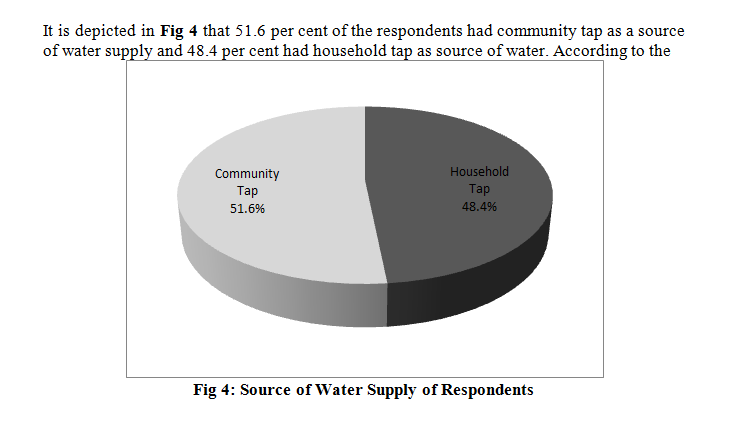
Census 2011, 56.7 per cent of respondents who lived in slums had household taps and 43.3 per cent had community taps as a source of water.
Water Storage Practices of Respondents
According to the Fig 5, 48.8 per cent and 47 per cent of the respondents used overhead tanks and plastic containers for storing water respectively.
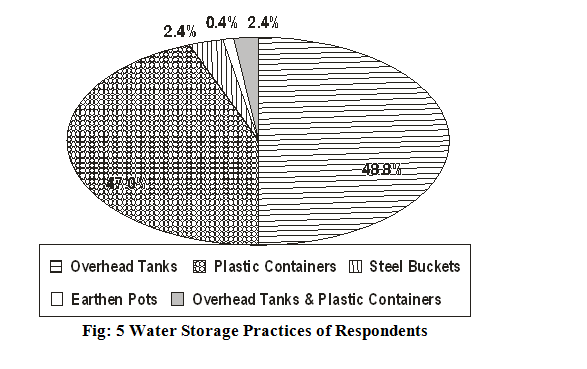
Toilet Facility Available to Respondents
According to the Fig 6, Majority of the respondents 59.6 per cent had proper toilet at their homes while remaining 40.4 per cent had no proper toilet at their homes. According to
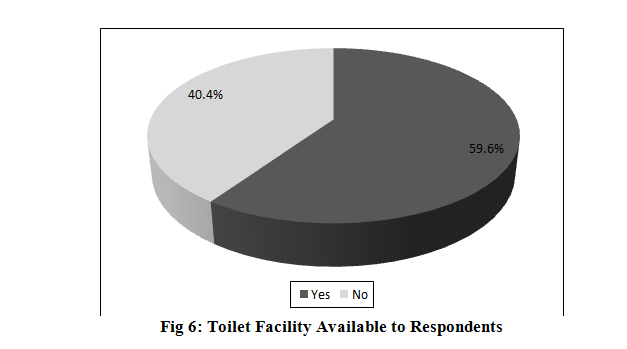
International Institute for Population Science (2006), in urban and rural areas 83 per cent and 27 per cent of respondents had no toilet facility at their homes. According to Census 2011, Mumbai, Delhi, Kolkata and Chennai, not even 10 per cent of poor households made. use of improved toilet facilities. In the other four cities, the proportion of poor households that used improved toilet facilities was also low—less than 30 percent. In Meerut, Indore, Nagpur and Delhi, 35 to 47 per cent of poor households had no toilet facility at all. The present study of slum dwellings of Chandigarh city witnessed higher percentage of people using improved toilet facility
BMI of Respondents
According to the Table 2, 37.8 per cent of the respondents were in the category of normal BMI whereas 23.8 per cent, 16.0 per cent and 17.8 per cent of the subjects suffered from grade I, grade II and grade III chronic energy deficiency (CED) respectively. The mean BMI of the subjects was 18.6 kg/m². According to the International Institute for Population Science (2006), 36 per cent of women who lived in slums were undernourished, with a BMI less than 18.5, indicating a high prevalence of nutritional deficiency, 13 per cent of women were overweight or obese.
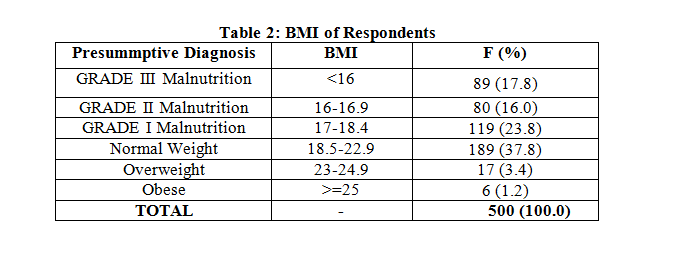
Relationship between BMI and Type of House
It is indicated in Table 3 that 24.2 per cent and 13.6 per cent of the respondents who lived in pucca and kuccha houses respectively had normal BMI. Only 3.4per cent and 1.2 per cent of respondents who used to live in pucca houses were overweight and obese. Respectively, while none of the respondents were found overweight and obese in kuccha houses. Highly significant association was found between BMI and type of house. The reason could be girls living in kuccha houses were more exposed to heavy domestic household chores as compared to girls living in pucca houses.
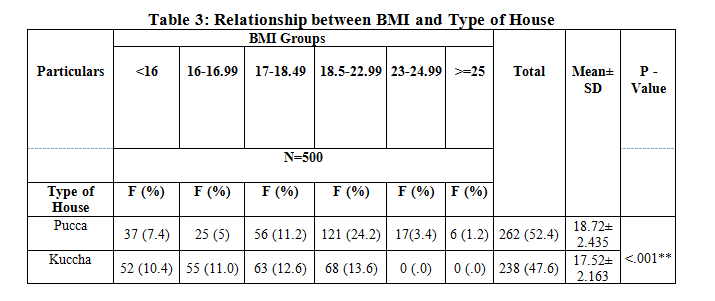
Conclusions
From the findings, it was found that poor living conditions like kuccha houses also force individual to compromise on nutritious requirements leading to poor health among young female children of slum areas especially who had to cater other domestic needs. It was also witnessed that poor nutritional intake lowered the BMI (Basal Metabolic Rate) leading to stunting, wasting and malnutrition. Urban slum girls who used to reside in pucca houses had higher BMI. The results of the present investigation had clearly highlighted that low BMI level indicated a poor health status of them. Childhood years are the most active and dynamic period of physical and mental growth of the child. Unfortunately in developing countries like India, the nutritional status of children especially those belonging to slum areas are very poor. In slum areas both the parents are usually working and their children especially girl children get deprived of the needed attention to be given on their health and healthy living conditions. It becomes the unsaid duty of the girl child to cater to the domestic needs of the house and up bring the siblings etc. Their living conditions also add on to their poor health status. Therefore it becomes the need of the hour to spread awareness, educate and promote healthy eating habits to ensure healthy and fruitful coming generations especially among girls. Education regarding personal hygiene and nutritional knowledge should be imparted through nutritional programs and the school curriculum in order to help them to improve and maintain their health.
References
Basta SS (1997) Nutrition and Health in Low Income Urban Areas of Third World. Ecol.Food Nutr 6:113-124.
Buri BR and Sai BM (1996) Comparision of Nutritional Status and Health Care of Women Residing in Urban, Rural and Slum Areas of Vishakhapattnam. The Ind J Nutrition and Dietetics33:293.
Census in India (2011) Available atcensusindia.gov.in/provisional population total/ Census.
Chanden S and Sehgal S (1994) Nutrition Status of School Age Children (7-9 years): A Comparative Study of Boys and Girls. The Ind J Nutrition Dietetics31:323.
Gopalan C (1989) Science and Nutrition in Future. Plenary Lecture XIV, International Congress of Nutrition, Seol.
Jondnali JP , Reddy SN , Vijay M and Nalwade N (2001) Nutritional Status of School Going Adolescent Girls of Parbhani. The Ind J Nutrition Dietetics 38: 262.
Kaul KK (1998) Nutritional Status of Children. In: Profile of Under Nutrition and Under Development. NFI Scientific Report 8, New Delhi: 55-80.
Mathur SM(1993) Study on Food Habits of Lactating Working and Non-Working Women in Peri-Urban Areas .Nutr . Abst and Rev 23(4):728-729.
Mohanty LNP and Mohanty S (2005) Slums in India. New Delhi: APH Publishers: 36-37.
Prakash V (2011) The Miserable Conditions of People Living in Indian Slums. Available at preservearticles.com/essay.
Rao S, Joshi, SB and Kelkar RS (2000) Studies on the Changes in Nutritional Status and Morbidity over Time among Pre-School Children from Slums in Pune, India. Indian Pediatr 37 (10): 1060-71.
World Health Organisation (2008) Mean Body Mass Index (BMI). Available at www.who.in/gho/ncd/risk_factors/bmi_text.

